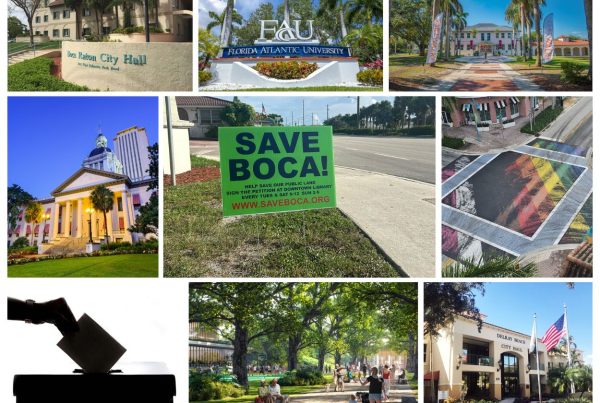University Village debate
“It’s getting to be the funny time,” Boca Raton Mayor Susan Haynie said early Wednesday morning. No kidding.
The city council meeting had rolled on past 11 p.m., and then midnight and then 1 a.m. as the council debated University Village. Based on concerns from council members and residents about the 77-acre, mixed-use project —some of the concerns legitimate, many not—City Attorney Diana Grub Frieser was making changes on the fly to the ordinance. Everyone was very tired.
Eventually, however, the council approved University Village, 4-1, Scott Singer dissenting. The added conditions seek to ensure that the appearance of the project matches as closely as possible the attractive renderings the council got from Penn Florida. The conditions also address the project’s compatibility with single-family neighborhoods to the east. Example: the buffer will be wider—100 feet—and will not have a pathway into University Village.
You can understand the council’s wish to scrutinize the project. The property is three times larger than Mizner Park. It’s the city’s largest undeveloped parcel. It’s a Planned Mobility Development, promising to limit the traffic impact from perhaps 1,500 residents and nearly 400,000 square feet of commercial development, including a hotel. The new Spanish River Boulevard interchange at Interstate 95 could both get new traffic out of the area quickly and bring more traffic.
As with most controversial projects, many speakers made bogus arguments. Some claimed that approving University Village would mean six-laning Spanish River Boulevard. Haynie asked the city’s traffic engineer to restate the city’s plan to keep the road at four lanes. Other speakers claimed that the apartments would draw Florida Atlantic University students, who would cause trouble.
In fact, the developer’s target markets are working millennials, retired Baby Boomers and FAU faculty and staff. None of those groups would want to share a neighborhood with undergraduates, who can live in other projects farther south that are closer to campus. Still, a condition restates the city’s rule about no more than three unrelated adults sharing a unit.
Then there was the issue of University Village being in the Boca Raton Airport flight path. What about safety? What about potential complaints about noise?
Regarding safety, many buildings—including Town Center Mall—already are under the flight path to the southwest. As Frieser pointed out, the developer—not the city—assumes the risk from any lawsuit resulting from a crash. The city is responsible only for land regulations. Regarding noise, it has been an issue for years. The bigger issue may be whether the developer can sell people on the idea of living there, given the noise.
Attorney Charles Siemon, who represents Penn Florida, told me Wednesday that he couldn’t recall another project to which so many changes were made at a council meeting. “I think the council did a good job,” he said.
Siemon said work on University Village could start in the spring. He’s biased, of course, but Siemon believes that the project “will be well-received when it starts to come out of the ground.” That’s hardly the sentiment today. “I just think it’s going to be horrible,” one speaker said. The indicator of change will be if the neighbors one day ask for that pathway into the project.
Boca Helping Hands clinic
Boca Helping Hands has helped to do one more favor for the community.
On Tuesday, a health clinic for what organizers call the “medically underserved” will open near downtown. It is a partnership between Boca Helping Hands and Boynton Beach-based Genesis Community Health.
Genesis obtained the roughly $1 million grant through the Affordable Care Act that will finance the clinic’s operations for two years. Genesis CEO DeAnna Warren said that if the clinic meets U.S. Health and Human Services guidelines, the grant could be extended.
Warren told me that organizers are targeting “everyone. Those on Medicaid, those without coverage, especially those who don’t have a primary care physician.” One will be available five days a week to start, with later hours on Tuesdays. The clinic will be on Southeast Sixth Street, between Dixie Highway and Federal Highway.
The main role for Boca Helping Hands will be getting people to the clinic. Director James Gavrilos said the organization sees 3,000 families each month who need food. “That’s maybe 5,000 or 6,000 people. If just 10 percent of them need access to health care, and if they use the clinic, that’s a lot of people.”
Gavrilos said his organization and Genesis have worked together for many years. Boca Helping Hands opened what Gavrilos called “a medical room,” and had dreamed of providing full-service care.
Warren said Genesis identified nearly 35,000 low-income potential patients within the city, using federal data broken down by ZIP code. Eventually, Boca Helping Hands would like to offer dental care, too. The clinic’s opening shows the strength of Boca Raton’s social fabric.
Tax credits
The need for a low-income health clinic in Boca Raton reminds us that for all the galas and fancy homes, the city has its share of residents trying just to get by. Fortunately, they also have organizations like Boca Helping Hands, Genesis and many others.
They also have the federal government. There is general bipartisan agreement that one of the country’s most successful anti-poverty programs has been the Earned Income Tax Credit, which Congress created 40 years ago an incentive for low-income Americans to work, rather than go on welfare.
Those who qualify received tax credits based on family size and income. The highest income level for eligibility is $53,267 for a married couple with three or more children. If the credits exceed the amount of taxes owed, the amount comes to the individual or couple as a refund. Almost 27 million Americans got benefits in 2014. One study estimated that the tax credit lowered the overall poverty rate by three percentage points and the rate among children by six-plus percentage points. The program especially helps single parents.
The Brookings Institution has compiled a database that breaks down Earned Income Tax Credit filing by, among other things, congressional district. The numbers for this area are interesting.
In District 22, which includes Boca Raton, Delray Beach and coastal cities from Palm Beach to Fort Lauderdale, about 77,000 Earned Income Tax filings went to the IRS in 2013—the most recent year available. That was roughly 23 percent of all returns filed.
From District 21, which includes areas west of Boca, Delray and Boynton Beach, the IRS got about 61,000 Earned Income Tax Credit filings. That was about 20 percent of the total.
Those numbers weren’t the highest from Florida. District 20, which includes some of Palm Beach and Broward County’s poorest areas, had 113,000 filers—36 percent of the total. But the numbers show that even in Boca Raton and Delray Beach the working poor make up a sizeable slice of the population. That’s worth keeping in mind over the holidays.








